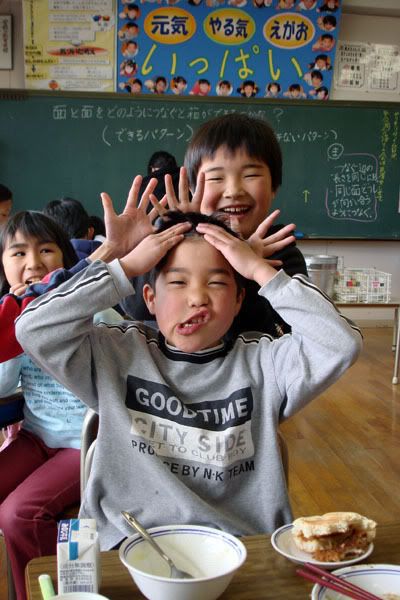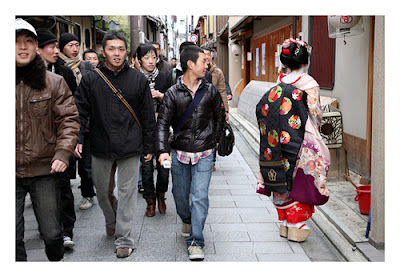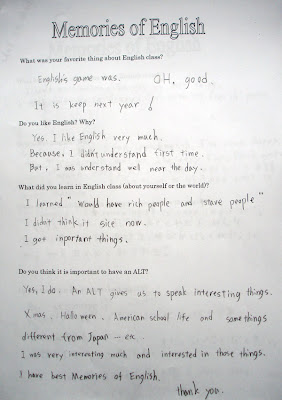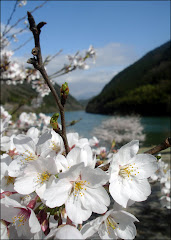Wednesday, March 28, 2007
Tuesday, March 27, 2007
The Brother is Back!
 Magome, a well-preserved, Edo period post town on the old Nakasendo, the road through the mountains that once connected the imperial capital of Kyoto to the Shogun's seat in Tokyo.
Magome, a well-preserved, Edo period post town on the old Nakasendo, the road through the mountains that once connected the imperial capital of Kyoto to the Shogun's seat in Tokyo.My brother is back in Japan, just in time for hanami and geisha-dancing goodness (^-^)/ He's super-genki and pretty popular in these parts, so we've been keeping busy, but tomorrow we leave for Kyoto! Tanoshimi!
Monday, March 19, 2007
Japan's Past, Japan's Future
 Geiko pose with two children of "double" heritage. Seeing this made me wonder... What will happen when Japan's new generation of multi-ethnic daughters grow up with an intrest in traditional culture and the desire to become a geiko? Obviously that is the very least of the questions that face Japan today, as it struggles to come to terms with Japanese citizens that don't quite fit their definition.
Geiko pose with two children of "double" heritage. Seeing this made me wonder... What will happen when Japan's new generation of multi-ethnic daughters grow up with an intrest in traditional culture and the desire to become a geiko? Obviously that is the very least of the questions that face Japan today, as it struggles to come to terms with Japanese citizens that don't quite fit their definition. Children with one Japanese parent and one non-Japanese parent are refered to as "half" here in Japan, a term most foreigners take acception to. Below is a quote from my fellow JET blogger, Gaijin For Life. His blog is witty, insightful, well-written, and all around much better than mine! Plus he has a super kawaii daughter (^-^). Read it. You won't regret it.
"I am not sure what children of "mixed marriages" are called in other countries, but here in Japan they are called "Half." I suppose that this is an implied reference to such a person's half that is lacking--that portion of them that is not Japanese. As for myself, when I was a kid growing up in Japan I always called them "half-n-halfs" but everyone thought I was talking about coffee. Now that I have a daughter who falls into the category under discussion, I use the term "Double." No one else does, but that must be because they are all under some sort of misconception. My daughter has two citizenships, a double portion of genetic diversity, and will soon speak two languages and carry two passports. That sounds like 1 times 2 to me, not 1 divided by 2."
Saturday, March 17, 2007
Ichimame's Blog: Buisness Trips
 Ichimame among the plum blossoms of Kitano Tenmangu shrine.
Ichimame among the plum blossoms of Kitano Tenmangu shrine.Friday, March 16, 2007
Tuesday, March 13, 2007
Ichimame's Blog: Study Meeting
I was also impressed by Ryuanji's mysterious rock garden. There are 15 stones, but no matter how you count, you can only see 14. The first time I counted only 14, but when I tried again there were 15. I was begining to wonder if there really were 15 stones, so when I found them all I was very happy.
I had a lot of fun, so I hope we have another study meeting like this again.
Monday, March 12, 2007
ALTS Can Make a Difference
 Left to right, top to bottom: Norie, Sumire and Nozomi (avid BLEACH fans and fellow Ichigo admirers), ME!, Etsuki, Nao, Natsuki, Ami, Takayo, Chikako.
Left to right, top to bottom: Norie, Sumire and Nozomi (avid BLEACH fans and fellow Ichigo admirers), ME!, Etsuki, Nao, Natsuki, Ami, Takayo, Chikako.The students who recently graduated from the Beautiful Mountain School meant a lot to me for many reasons. We entered the school together, me, fresh off the airplane, and them, in their brandspankin' new uniforms, straight out of their tiny mountain elementary schools, where they had only seen an ALT once or twice a year. I knew about as much about teaching English as they did about speaking it. At first they were shy, and it took a long time before they felt comfortable with me. During my first year I was sent to 16 different schools, mostly elementary schools, and had a very hard time getting to know the students, teachers, or understanding exactly what my job was supposed to be.
During my second year, I was blessed with a change. My schedule included only four different schools, with Ena Kita Chu as my base. I visited them about 90 times, and their cheerfulness, friendliness, and willingness to always do their best really endeared them to me. It was easy for me to learn all their names and identify their strong a week points, not only as a class, but as individuals. I gave them the opportunity to write to me about anything they wanted in English "journals", and to my suprise, almost everyone did at least once a week. They told me about their everyday lives, their families, their friends, their hobbies, their likes and dislikes and their culture. Slowly the gap betweeen sensei and student, foreigner and Japanese, began to close. I always wrote back to them, and was excited to see students rushing to collect their journals from the teacher to see what I had written. To me, they became more and more like little brothers and sisters, and to them, I became more and more like a friend.
In the time I had been visiting the school regularly (three days a week for a year), both the JTE and I were amazed at how quickly their English writing, listening, and speaking had improved, not to mention their confidence and participation in class. They had begun to love English, and it showed. Of the 36 students, 25 of them opted to take the national English standards test, and all passed.

Unfortunately, in my third year, the schedule changed again. My visits to Kita Chu were cut to 94, or twice a week if I was lucky. Instead I was placed at a much larger school where I stood silently in the classroom as the teachers droned on for ages in Japanese. This only made my time at Kita Chu more precious. When I did visit, the students and I often talked so much at lunch (in ENGLISH) that no one ever finished eating on time. During recess, students always came to talk to me, invited me to the library or asked me to play basketball or soccer with them.
The reason I am saying all this, and sharing these letters and comments from my students, is because I know that some people doubt that ALTs are making any contribution to English education in Japan. I know that some ALTs doubt it, too, but I want everyone to know that there are ALTs who are making a difference. Given the opportinity, ALTs can be an invaluable English teaching tool, a catalyst for change, and an open window to the world.
If you'd like to read the surveys, you can veiw a larger size by clicking on the pictures. I have translated the Japanese below.
Do you like English? Why? (Japanese)
Even when I become an adult, I will study English as a hobby.
What did you learn in English class (about yourself or the world)?
Everyone that has come as an ALT has spoken to us from their heart, called out to us. So I was able to speak from my heart, too.
Do you think it is important to have an ALT?
Thanks to Melissa, I came to love English!


What was your favorite thing about English class?
Do you think having an ALT is important?
Sunday, March 11, 2007
Is it Important to Have an ALT?




 I think it`s better if there is an ALT (if it`s Melissa).
I think it`s better if there is an ALT (if it`s Melissa). ALTs are interesting! They keep the conversation flowing! I enjoyed it!
ALTs are interesting! They keep the conversation flowing! I enjoyed it! It`s better if there is an ALT. The lessons are easier to understand (with the ALT).
It`s better if there is an ALT. The lessons are easier to understand (with the ALT).


 I think it is necessary. We can remember foreigner's pronunciation and speak at ease with the ALT.
I think it is necessary. We can remember foreigner's pronunciation and speak at ease with the ALT. I think it is very important because we can learn about the ALT"s country and culture (we can hear about celebrities and many different things that we don`t know about).
I think it is very important because we can learn about the ALT"s country and culture (we can hear about celebrities and many different things that we don`t know about).
 I think it is necessary. It is more interesting and fun when they are here.
I think it is necessary. It is more interesting and fun when they are here.

 There are many sounds (in English) that are diffcult for Japanese people to pronounce, so I think it is necessary to have an American or someone like that (a foreigner) in class.
There are many sounds (in English) that are diffcult for Japanese people to pronounce, so I think it is necessary to have an American or someone like that (a foreigner) in class.
Thursday, March 08, 2007
Graduation: Shikishi
 A shikishi is a square piece of fancy card board used for autographs, calligraphy and poetry. At the end of the year, students usually sign them with a short message to their teachers, thanking them for the year. The 3rd year students at my Beautiful Mountain School presented this to me at the end of our last lesson on Thursday. I certainly wasn`t expecting it, and when I saw Takayo bringing it to the front of the classroom before we did the closing greetings, my eyes filled up with tears and I hid behind my JTE. They graduated today, and I cried all over again. I miss them already!
A shikishi is a square piece of fancy card board used for autographs, calligraphy and poetry. At the end of the year, students usually sign them with a short message to their teachers, thanking them for the year. The 3rd year students at my Beautiful Mountain School presented this to me at the end of our last lesson on Thursday. I certainly wasn`t expecting it, and when I saw Takayo bringing it to the front of the classroom before we did the closing greetings, my eyes filled up with tears and I hid behind my JTE. They graduated today, and I cried all over again. I miss them already!Wednesday, March 07, 2007
Oi Sho: A Happy Place
 Energetic, Motivated, Smiley! The 3rd graders of Oi Sho. Do these guys look familiar? JAPAN!
Energetic, Motivated, Smiley! The 3rd graders of Oi Sho. Do these guys look familiar? JAPAN!
Well, I spent recess getting farted to death by 2nd graders, at which point the offenders piled on top of my listless body, tickling me to tears. It was fantastic--especially since they were fake farts-- which I then spent the rest of the day dodging in the hallways.
Other than that, I had only one class because 1st, 3rd, 5th, and 6th grade classes were cancelled due to some kind of incredible epidemic.

Sunday, March 04, 2007
Baikasai: The Plum Blossom Festival
 Ichimame prepares matcha (powdered green tea) as Naozome prepares to serve it to a guest.
Ichimame prepares matcha (powdered green tea) as Naozome prepares to serve it to a guest.
 A long line of geiko and maiko, easily distinguished by the way in which they wear their obi, bow as they serve tea to their guests.
A long line of geiko and maiko, easily distinguished by the way in which they wear their obi, bow as they serve tea to their guests. Umeshizu and Umechika, geiko of Kamishichiken.
Umeshizu and Umechika, geiko of Kamishichiken. Umeha and Umeshizu prepare, as Naozome offers tea to the guests.
Umeha and Umeshizu prepare, as Naozome offers tea to the guests.




















